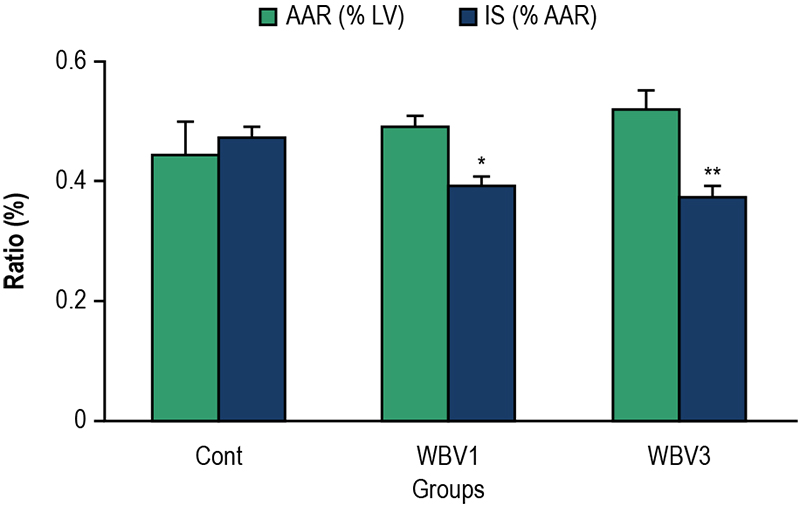Volume 112, Nº 1, January 2019
DOI: http://www.dx.doi.org/10.5935/abc.20180252
ORIGINAL ARTICLE
Whole-Body Vibration Training Increases Myocardial Salvage Against Acute Ischemia in Adult Male Rats
Shahnaz Shekarforoush
Mohammad Reza Naghii

Figure 1 – Infarct size (IS) and area at risk (AAR) following 30-min of ischemia and 120-min of reperfusion in rats. LV: left ventricle; * p < 0.05 and ** p < 0.01 compared with the control group. Cont: control; WBV1: whole body vibration training for one week; WBV3: whole body vibration training for 3 weeks.
Abstract
Background: Whole body vibration training (WBV) is a new training program, which is safe and effective. It can be followed by the public. However, data on the safety and efficacy of vibration on myocardial ischemia reperfusion (IR) injury are lacking.
Objective: To examine the effect of WBV on the tolerance of the myocardium to acute IR injury in an experimental rat model.
Methods: Twenty-four male Wistar rats were divided into control and vibration groups. Vibration training consisted of vertical sinusoidal whole body vibration for 30 min per day, 6 days per week, for 1 or 3 weeks (WBV1 and WBV3 groups, respectively). All the rats were submitted to myocardial IR injury. Myocardial infarct size and ischemia-induced arrhythmias were assessed. Differences between variables were considered significant when p < 0.05.
Results: No differences were observed between the groups regarding the baseline hemodynamic parameters. Infarct size was smaller in the experimental group (control, 47 ± 2%; WBV1, 39 ± 2%; WBV3, 37 ± 2%; p < 0.05, vs. control). Vibration produced a significant decrease in the number and duration of ventricular tachycardia (VT) episodes compared to the control value. All ventricular fibrillation (VF) episodes in the vibration groups were self-limited, while 33% of the rats in the control group died due to irreversible VF (p = 0.02).
Conclusion: The data showed that vibration training significantly increased cardiac tolerance to IR injury in rats, as evidenced by reduction in the infarct size and cardiac arrhythmias, and by facilitating spontaneous defibrillation. (Arq Bras Cardiol. 2019; 112(1):32-37)
Keywords: Rats Wistar; Body Composition; Vibration; Osteoporosis/prevention and control; Blood Viscosity; Ischemia; Cardiovascular Diseases; Ischemic Preconditioning















